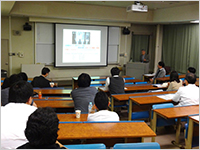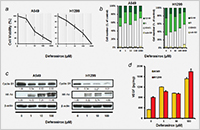An oral presentation at a multidisciplinary fusion study symposium in 2014
Enlarge Image <Picture 2>
An oral presentation at the multidisciplinary fusion study symposium for inflectional disease using iron control technique 2015
Enlarge Image <Fig.1>
Iron-depletion inhibited cell proliferation via cell-cycle arrest and induced VEGF secretion in vitro. (a) Cultured A549 cells and H1299 cells were treated with the indicated concentrations of deferasirox for 24 h and the cell viability was measured by the WST-1 method. (b) The cells were treated with different concentrations of deferasirox for 24 h and the cell-cycle distribution was analyzed by flow cytometry. Each histogram consists of the following four cell cycle populations; sub-G0 (black), G0-G1 (white), S (light gray) and G2-M (dark gray). (c) Whole-cell lysates and the nuclear protein of these cells treated with the indicated concentrations of deferasirox were used for Western blot analysis to determine its inhibitory effects on cell cycle and upregulation effects on HIF-1a. The expression level of each protein was calculated relative to its expression in mock-treated cells, whose expression level was designated as 1. (d) Supernatant treated with the indicated concentrations of deferasirox was harvested and VEGF secretion examined by ELISA.
Enlarge Image
Developing new insights into iron-controlled biology
Iron is the most common metal on Earth and an essential element for all living creatures. Thus, iron control is a potential candidate for therapeutic applications. There are many researchers studying iron at Okayama University. Multi-disciplinary workshops have been held from time to time to connect the various research fields including medicine, engineering and science (Picture 1).
As well as healthy cells, cancer cells also need iron to proliferate and metastasize. Dr. Toshiaki Ohara (M.D., Ph.D.) and colleagues are developing a new therapy to decrease the iron content in cancer tumors (Literature 1& Fig.1). A clinical study for hepatocellular carcinoma patients is ongoing in Okayama University Hospital supported by the Princess Takamatsu Cancer Research Fund.
Researchers are also considering whether an iron-control technique is applicable for dealing with infection (Literature 2). On 18 March 2015, a multidisciplinary fusion study symposium for inflectional disease using an iron-control technique was held (Picture 2). The participants discussed the iron dependency of pathogenic bacteria. The symposium enabled attendees to share their knowledge and connect the various research fields.
We are now gathering more colleagues to study iron control in the different research disciplines.
Literature 1:
A novel synergistic effect of iron depletion on antiangiogenic cancer therapy:http://onlinelibrary.wiley.com/doi/10.1002/ijc.27943/abstract
Literature 2:
Iron controlled therapy for cancer and inflectional disease (Japanese / English):http://www.okayama-u.net/renkei/document/pdf/oogata_tenjikai/4_lifescienceworld/2015/3_ohara.pdf
For reference:
Princess Takamatsu Cancer Research Fund:http://www.ptcrf.or.jp/english/index.html
Okayama university hospital:http://www.hsc.okayama-u.ac.jp/hos/en/index.html
【Correspondence】
Department of Pathology & Experimental Medicine, Okayama University Graduate School of Medicine, Dentistry, and Pharmaceutical Sciences
Associate professor Toshiaki Ohara
TEL:+81-86-235-7143
e-mail:t_ohara@cc.okayama-u.ac.jp
http://www.okayama-u.ac.jp/user/byouri/pathology-1/TOP.html



